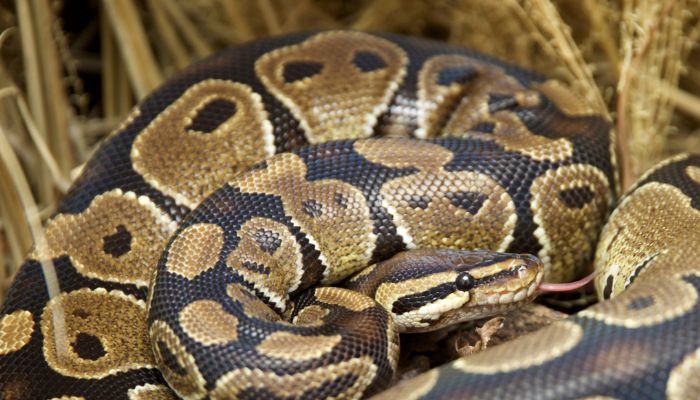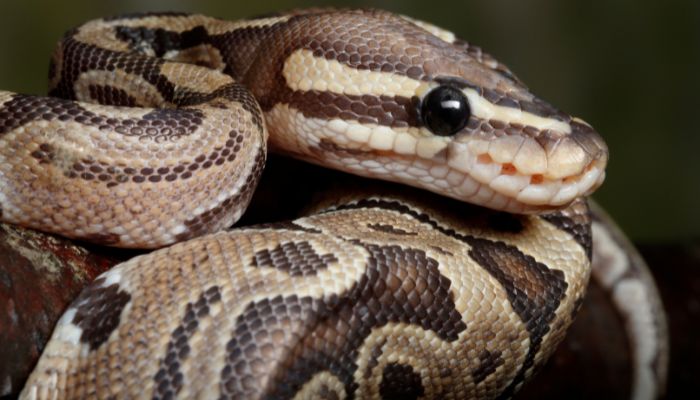Ever wondered why ball pythons, those fascinating reptilian pets, curl up into a tight ball?
Ball pythons “ball up” primarily as a defense mechanism. When threatened or stressed, they coil their body tightly to protect their vulnerable head and neck. This behavior, honed over millennia, helps them evade predators in the wild. In captivity, frequent balling up might indicate stress or discomfort.
Dive into this comprehensive guide to unravel the mystery behind this unique behavior.
From understanding their natural defense mechanisms to the subtle signs of health concerns, we’ll explore the myriad reasons behind the “balling up” phenomenon.
Whether you’re a curious reader or a concerned pet owner, this article sheds light on the captivating world of ball pythons, offering insights into their behavior in both the wild and captivity.
Let’s embark on this scaly adventure together!

Table of Contents
The Unique Behavior of Ball Pythons: Balling Up
The ball python is one of the most popular pet snakes around, and for a good reason. But have you ever wondered about that peculiar behavior they exhibit? You know, the one where they curl up into a tight ball, tucking their head inside? Let’s dive deep into this behavior.
The “Balling Up” Behavior
Imagine you’re a small creature in the wild, surrounded by potential threats. What would you do to protect yourself?
For the ball python, the answer is simple: ball up! When a ball python feels threatened or stressed, it coils its body tightly, wrapping itself into a protective ball. This behavior isn’t just a random act; it’s a strategic move.
By coiling up, the python protects its vulnerable head and neck from potential predators. It’s like their version of curling up under a cozy blanket when the world feels a bit too overwhelming.
How They Got Their Name
Now, here’s a fun fact for you. The name “ball python” is directly derived from this unique behavior. When explorers and early snake enthusiasts first observed these snakes in the wild, they noticed this coiling behavior and aptly named them “ball pythons.”
It’s kind of like naming a dog “bark dog” because it barks, but way cooler, right?
The ball python’s ability to ball up is not just a quirky trait; it’s a testament to their survival instincts and adaptability. Over the years, this behavior has allowed them to evade predators and thrive in their natural habitats.
And now, in our homes, it serves as a reminder of their wild instincts and the fascinating world of reptiles.

The Primary Reasons for Balling Up
Alright, so we’ve established that ball pythons have this super cool behavior of balling up. But why do they do it? Let’s unravel the mystery behind this behavior by diving into some of the primary reasons.
Defense Mechanism
In the wild, danger lurks around every corner. Predators are always on the prowl, and for a ball python, balling up is a nifty trick to avoid becoming someone’s dinner.
By curling into a tight ball, they protect their most vulnerable parts, especially their head. It’s a bit like us humans curling into a fetal position when scared or threatened. For potential predators, a balled-up python is less appealing, as it’s harder to find an opening to attack.
Thermoregulation
Temperature plays a vital role in the life of a reptile. Ball pythons, being ectothermic, rely on external sources to regulate their body temperature. Balling up can help them conserve body heat, especially during colder periods.
Think of it as them huddling up for warmth, much like you’d wrap yourself in a blanket on a chilly night.
Stress and Discomfort
Just like humans, snakes can feel stress and discomfort. Changes in their environment, loud noises, or even the presence of other animals can stress them out. When they’re feeling uneasy or threatened, balling up can provide a sense of security and comfort.
Shedding Process
Shedding is a natural process for snakes, where they shed their old skin to make way for new growth. During this period, their skin becomes more sensitive, and their vision can be obscured due to the old skin covering their eyes.
Balling up during this time can be a way to protect themselves and feel secure as they go through this vulnerable phase.

Balling Up in Captivity vs. Wild
Now, let’s take a moment to compare the behavior of ball pythons in captivity versus their wild counterparts.
Differences in Behavior
In the wild, ball pythons face a myriad of challenges, from predators to harsh weather conditions. Balling up is often a life-saving behavior in such scenarios. In captivity, while the threats are minimal, the behavior persists.
However, frequent balling up in captivity might indicate stress, discomfort, or health issues, which is different from the wild, where it’s more about immediate survival.
Proper Care to Reduce Balling in Captivity
If you’re a ball python owner, it’s essential to ensure your pet feels safe and comfortable. Providing a proper habitat, maintaining the right temperature, and regular health check-ups can reduce the frequency of balling up.
Remember, while it’s a natural behavior, frequent balling up in captivity might be a sign that your python needs some extra care or attention. Always be observant and responsive to their needs. After all, a happy python is a healthy python!

Observing and Interacting with a Balling Ball Python
The joys of observing these magnificent creatures! But wait, what if your ball python is constantly balling up? How should you, as a pet owner, interact with it? Let’s dive into some essential tips and tricks.
Tips for Pet Owners
First and foremost, patience is key. If your ball python is balling up, give it some time. Remember, this behavior is a sign that they’re feeling threatened or stressed. Instead of immediately reaching out, observe from a distance.
Over time, as your python gets accustomed to its surroundings and to you, the frequency of this behavior should decrease.
When to Leave the Snake Alone
If your ball python remains in a balled-up position for extended periods, especially after a change in its environment or a stressful event, it’s best to give it some space.
Just like us humans needing some alone time after a stressful day, your python needs the same. Allow it to relax and feel secure in its environment.
Safe Handling Practices
When handling your ball python, always approach it slowly and gently. Avoid sudden movements or loud noises. If it’s balled up, wait for it to uncoil before attempting to handle it. Remember, safety first – both for you and your python!

Health Concerns and Balling Up
Now, while balling up is a natural behavior, it’s essential to be vigilant. Sometimes, this behavior might indicate underlying health issues.
When Balling Up Might Indicate Health Issues
If your ball python is balling up more frequently than usual, combined with other unusual behaviors like refusal to eat, lethargy, or irregular shedding, it might be a sign of health concerns. For instance, respiratory infections, mites, or digestive issues can cause discomfort, leading to increased balling up.
Other Symptoms to Watch Out For
Apart from balling up, keep an eye out for symptoms like wheezing, mucus around the mouth, irregular scales, or a change in the color and texture of their droppings. Any of these signs, combined with frequent balling up, should be a red flag.
In such cases, it’s always best to consult with a reptile veterinarian. They can provide a proper diagnosis and treatment plan to ensure your ball python remains healthy and happy. After all, our scaly friends deserve the best care, don’t they?
Final Word
You’ve journeyed through the intriguing world of ball pythons, uncovering the reasons behind their unique “balling up” behavior.
From natural defense mechanisms to signs of health concerns, understanding these aspects can enhance your experience as a pet owner.
Remember, every behavior offers insights into their well-being. As you continue observing and caring for your ball python, let this knowledge guide you.
With patience and understanding, you’re well on your way to ensuring a happy and healthy life for your scaly companion. Keep up the great work!
More Questions
The life of a ball python owner is filled with questions! It’s only natural to be curious about the well-being and behavior of your scaly companion. Let’s tackle some of the most common queries.
How Do I Know if My Ball Python is Happy?
A content ball python will have a regular feeding pattern, shed its skin uniformly, and explore its habitat with curiosity. If it’s active, has clear eyes (except during shedding), and doesn’t ball up excessively, you’ve got a happy snake on your hands!
What Do Ball Pythons Do When Scared?
Apart from the obvious balling up, a scared ball python might hiss, try to flee, or even strike out in defense. It’s their way of saying, “Hey, I’m not comfortable here!”
How Do You Calm a Ball Python?
Speak softly, move slowly, and handle them gently. Creating a calm environment, maintaining a consistent routine, and offering a secure hiding spot in their habitat can also help in keeping them relaxed.
When Should I Not Pick Up My Snake?
Avoid handling your ball python during shedding, right after feeding, or if it’s showing signs of stress or illness. These are times when they’re most vulnerable, and it’s best to let them be. Remember, understanding and respecting their boundaries is the key to a happy relationship with your python!




0 Comments